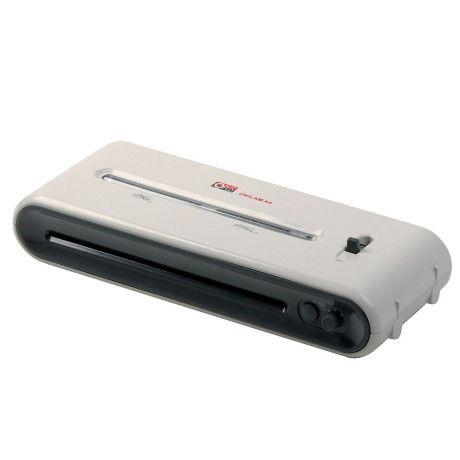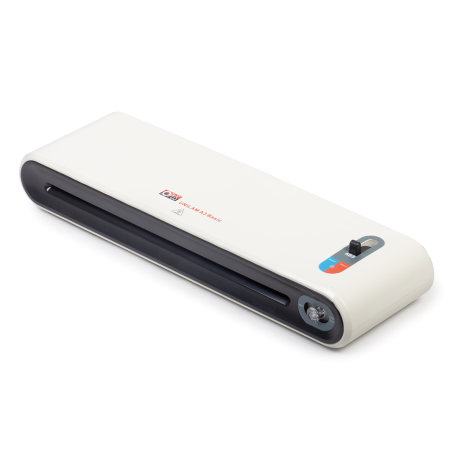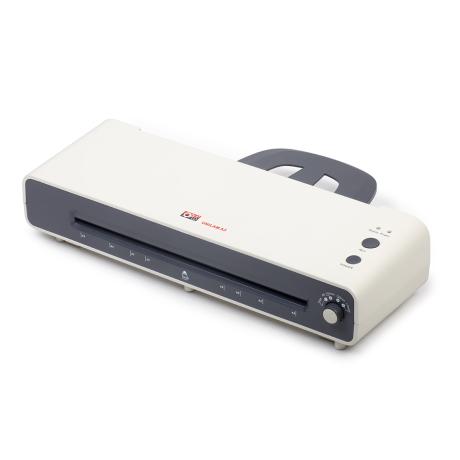Thinking about buying an office laminator to protect your business records? Check out our buying guide to help you make the right decision. Learn about some recommended laminator models that are very popular.
Laminating is a way of protecting documents by covering them with a special film. Laminating provides protection against tearing and abrasion, getting wet, yellowing of the paper, loss of colour saturation or attempts to make unauthorised changes. Laminators are used to laminate documents evenly. These devices bond the sheet to the foil using a cold or hot method. They can be equipped with additional functions and are suitable for handling documentation in various formats.
Laminate can be used to laminate, among other things:
Laminators designed for the office should be characterised by good performance, fast operation and intuitive handling. Depending on the model, they can also be used to protect colour photos and for use with glossy paper. It is worth considering equipping your office with a laminator if you secure larger quantities of documents. This reduces costs by dispensing with the services of an external contractor.

Depending on the model, office laminators can handle A4 print or larger formats such as A3 or A2. When choosing a laminator, it is crucial to determine the maximum size of documents you want to secure. With a laminator for A4 material, we can easily secure content on A5 paper or smaller.
Laminators for A3 and A2 documents will find use among others in advertising agencies and in building and architectural offices, where project documentation is prepared on larger sheets of paper. However, in most office applications laminators for A4 prints are perfectly adequate.
Office laminators can laminate documents either cold or hot. You can find devices that allow the use of only one of these methods or universal models, with the option of choosing either method.
Cold lamination involves the use of adhesive-coated film, which adheres to the document due to the pressure of the laminator rollers. The big advantages of this technique are the short laminating time and the possibility of protecting prints covered with ink that is not resistant to high temperatures. The disadvantage is the reduced adhesive strength.
Hot lamination, on the other hand, involves using heated laminator rollers to dissolve the adhesive with which the film is coated. It is pressed against the document and additionally sealed at the edges, as the films are up to 6 mm larger than standard formats. A document laminated in this way is embedded in the film and is characterised by greater strength, which is why this method is definitely more popular.
Depending on the manufacturer and the specific model, office laminators may have additional features and functions that make work easier. These include:
Office laminators differ in a number of technical parameters that determine their nature of work and suitability for specific applications. The first of these is the maximum thickness of the laminating film expressed in microns (µm), which is usually specified in the product data sheets for a particular machine. Manufacturers of reputable equipment also include information on the maximum thickness of the document with the film in millimetres. As a rule, the thicker the film, the better the protection of the laminated document. However, we must remember that this is associated with greater rigidity, which will be an advantage or disadvantage depending on the intended use of the specific document.
Another important factor is the type of film allowed. Office laminators can work with glossy, matt, self-adhesive and adhesive films, as well as glossy papers. It is important to use only solutions approved by the machine manufacturer. In the case of hot lamination, we should also be interested in the temperature range of lamination - the use of a temperature unsuitable for the requirements results in ineffective and unsightly gluing.
In terms of productivity, the most important factor is the laminating speed expressed in millimetres per minute. It is mainly dependent on the heating time of the laminator and the number of heating rollers. A higher number of rollers results in a more even finish. Remember, however, that not all rollers are heated. Individual manufacturers may indicate the number of so-called hot and auxiliary rollers. Laminating speed should be taken into account especially for offices that produce large quantities of documents, such as advertising agencies. The heating time of the laminator is also an important parameter.
At the stage of choosing a laminator, it is worth considering where it will ultimately be located and taking into account its size and weight. We can choose from compact models with a low weight of 3-5 kg or more powerful and larger laminators designed to secure larger amounts of documentation.
For those considering choosing a laminator, we have prepared a list of four models that we can confidently recommend for office use. Among the suggestions we have included both smaller models and fully professional devices for the most demanding.
Our list opens with the OPUS uniLAM A4 office laminator designed for cold or hot laminatingA4 documentation. On its price shelf it is definitely one of the best options. It provides quiet and efficient operation and easy handling. A maximum laminating speed of 300mm/min and the handling of 80-125µm film translates into satisfactory laminating results. The machine is equipped with an ABS anti-blocking button and light indicators. All this makes the uniLAM A4 the perfect choice for smaller offices.


OPUS uniLAM A3 Basic is aimed at those who secure documentation also in A3 format. It offers a maximum laminating speed of 300 mm/min and works with 80-125 µm films. The machine is designed for hot lamination with temperatures of 100o C-140o C. It is a great choice if you are looking for a device with a good price/quality ratio.
The classic OPUS uniLAM 3 laminator is designed for anyone looking for a laminator that supports A3 format and offers both hot (up to 150o C) and cold lamination. This model allows the use of film thicknesses from 80 to 175 µm. The machine's big advantages are the reverse function and four hot rollers. The robust construction, aesthetically pleasing casing and modern design mean that the device will fit in well with any office décor.


The OPUS profiLAM A3 professional office laminator is recommended for demanding users who expect high productivity and top quality lamination. It allows laminating with film thicknesses up to 250 µm, both cold and hot at speeds up to 1800 mm/min. The machine is equipped with six rollers and a liquid crystal display. A temperature programmer and digital 9-stage speed control allow the user to select the optimum settings for lamination parameters. A reverse function, standby mode and sound and light signals provide convenience.